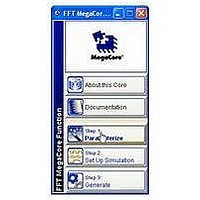IPR-FFT Altera, IPR-FFT Datasheet - Page 32

IPR-FFT
Manufacturer Part Number
IPR-FFT
Description
IP CORE Renewal Of IP-FFT
Manufacturer
Altera
Type
MegaCorer
Specifications of IPR-FFT
Software Application
IP CORE, DSP Filters And Transforms
Supported Families
Arria GX, Cyclone, HardCopy, Stratix
Features
Bit-Accurate MATLAB Models, Radix-4 And Mixed Radix-4/2 Implementations
Core Architecture
FPGA
Core Sub-architecture
Arria, Cyclone, Stratix
Rohs Compliant
NA
Function
Fast Fourier Transform Processor
License
Renewal License
Lead Free Status / RoHS Status
na
Lead Free Status / RoHS Status
na
2–12
Simulate with IP Functional Simulation Models
Simulating in Third-Party Simulation Tools Using NativeLink
FFT MegaCore Function User Guide
f
You must ensure that the length of the input vector is at least as large as the sum of the
transform sizes for the model to function correctly.
The wizard also creates the MATLAB testbench file <variation name>_tb.m. This file
creates the stimuli for the MATLAB model by reading the input complex random data
from files generated by IP Toolbench.
To model your variable streaming architecture FFT MegaCore function variation in
the MATLAB software, follow these steps:
1. Run the MATLAB software.
2. In the MATLAB command window, change to the working directory for your
3. Perform the simulation:
To simulate your design, use the IP functional simulation models generated by IP
Toolbench. The IP functional simulation model is the .vo or .vho file generated as
specified in
simulation environment to perform functional simulation of your custom variation of
the MegaCore function.
For more information about IP functional simulation models, refer to the
Altera IP in Third-Party Simulation Tools
Handbook.
You can perform a simulation in a third-party simulation tool from within the
Quartus II software, using NativeLink.
project.
a. Type help <variation name>_model at the command prompt to view the
b. Run the provided testbench by typing the name of the testbench, <variation
1
input and output vectors that are required to run the MATLAB model as a
standalone M-function. Create your input vector and make a function call to
<variation name>_model. For example:
or
name>_tb at the command prompt.
nps=[256,2048];
inverse = [0,1]; % 0 => FFT 1=> IFFT
x = (2^12)*rand(1,sum(nps)) + j*(2^12)*rand(1,sum(nps));
[y] = <variation name>_model(x,nps,inverse);
If you selected bit-reversed output order, you can reorder the data with the
following MATLAB code:
y = y(bit_reverse(0:(FFTSIZE-1), log2(FFTSIZE)) + 1);
where
“Set Up Simulation” on page
function y = bit_reverse(x, n_bits)
y = bin2dec(fliplr(dec2bin(x, n_bits)));
bit_reverse
is:
chapter in volume 3 of the Quartus II
2–7. Compile the .vo or .vho file in your
© December 2010 Altera Corporation
Chapter 2: Getting Started
Simulate the Design
Simulating















